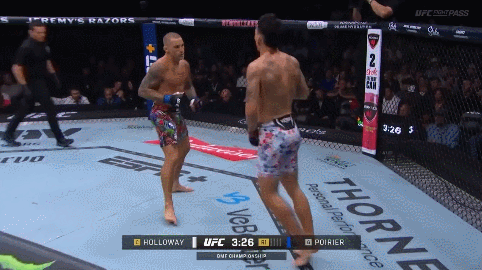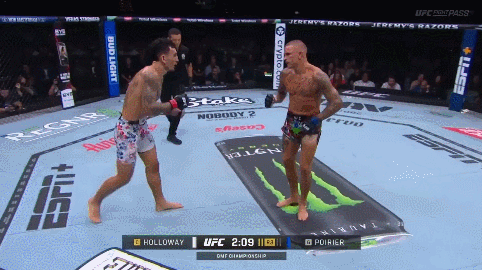Predatory instinct: how Max Holloway attacks
Max Holloway gave Dustin Poirier the most respectful treatment any fighter can give to his rival: by beating his ass like a rented mule.
Few things testify to a fighter’s greatness as well as what he does when his best days are behind him. This is a huge part of Roberto Duran’s legacy; the fact that he was still winning fights 20 years after his peak is truly the stuff of legend. As for MMA fighters, who could argue that Jose Aldo is one of the best to ever do it, when he was still racking up victories a decade after he first lost his title?
Now Max Holloway is busy writing his own epilogue.
To some, the idea that Max Holloway is in any way over the hill might seem strange. After all, he’s only 33. In terms of mileage, however, Holloway is far from a young fighter. He is nearing his 16th year, in a sport that grinds most competitors down to a nub in 10. And he has been fighting the best of the best, with very few exceptions, for all but two of those years. It was February of 2025 when Holloway made his UFC debut against none other than Dustin Poirier. He was just 20 years old at the time.
It may seem stranger still to talk of Max Holloway’s age when it was Dustin Poirier who retired after fighting him a third time at UFC 318. Still, I think it’s important to recognize what Holloway is doing now, at this stage of his career. Because while he may be losing some of his youthful vigor, he is also getting better.
Aside from nostalgia, that was the great appeal of this matchup: the question of how much it might have changed over time. Max Holloway is a different fighter than he used to be, and not all the changes are negative. He is less reliant on raw aggression, more capable of conducting a fight off the back foot. He is better defensively, better at counter punching. In many ways he is sharper, cleverer, craftier than before. Because he has to be, yes. But great fighters do what they must.
It was abundantly clear just how much this matchup had changed when Holloway knocked Poirier down less than two mintues into the first round.
It starts with a bit of handfighting. This game of lead hand patty-cake happens so often in matchups between fighters of opposite stances that it can become a sort of mindless reflex to engage in it. In this case it is Dustin Poirier who blunders into the trap. He advances, pawing with the lead hand, only for Holloway to check it sharply with his own. Poirier takes another step forward, reaching for Holloway’s hand again. Max reaches out in turn—but this time he snatches his hand away before Poirier can make contact. While Poirier’s lead hand floats in empty space, wondering where its friend went, Holloway moves in, stepping past Poirier’s lead foot and slapping with a left hook. Dustin double blocks, not only raising the right elbow as a shield but covering his jaw with his left hand—which leaves him wide open for Holloway’s straight right.
In principle, this trap is similar to the classic hook off the jab, except it’s a counterattack. Instead of gaining a tempo with the threat of the jab, Holloway recognizes that Poirier is giving that time away for free. He uses Poirier’s own insistence on the handfight against him. It’s remarkable how quickly he seizes on the idea, too. You need at least two beats to establish a rhythm, but Holloway reads Poirier’s flow so perfectly that he manages to interrupt before beat two has even landed.
But what turns this from a nasty surprise into a knockdown is the fact that Holloway follows up. He doesn’t just see Poirier’s right hand leaving his chin and think “he’ll be open for the left hook now.” He throws the left hook knowing that Poirier will defend it. He forces Poirier to defend it, which not only creates an opening in Poirier’s guard, but generates the tempo Holloway needs to exploit it.
Max continued using the handfight to his advantage throughout the entire bout. Here’s another nifty attack from round three. This time, the setup is a little more tactile in nature.
The first time Holloway checks Poirier’s right hand, he feels him pushing back. The next time their hands meet, he resists. This moment of tension puts Poirier on high alert. He stops advancing—in fact, as Max gives him a subtle body feint, he instinctively recoils, not only pulling back but shying away to his left. The intention is to get off the line of fire, but take a look at his feet in this moment (just as the fight clock reads 2:06). With this one, small clockwise movement, Poirier concedes the battle for foot position, giving Holloway a clear lane to the outside angle.
Never one to waste an initiative, Holloway pounces. But, once again, he attacks in layers. Breaking his grip on Poirier’s hand, he threatens with a jab to the body. At the same time, he steps off to the left, seizing the angle Poirier has given him. Even as Dustin drops his hand to ward off the body jab, Max is already sending another jab straight at his face. It makes contact, though Poirier manages to flinch away at the last instant. The right hand that follows, however, lands perfectly flush. Take a look at Holloway’s feet as he lands that right hand. See how he brings the right foot with him as he throws, not leaving it stuck out behind him as so many fighters are wont to do.
I also want to highlight just how perfectly timed all of Holloway’s movements are. He gains access to the outside angle from the handfight, but he does not waste time trying to get there before launching his attack. If he had, then Poirier would have simply adjusted his feet again and taken the angle away from him. Such positional openings are fleeting. Instead, Holloway buys time for the adjustment with an immediate assault. His footwork is perfectly married to the rhythm of his punches. Only when he launches his final right hand has he finally achieved the textbook outside angle, and almost as soon as it lands, Poirier resets, and the positional battle starts all over again.
But let’s talk about how Max Holloway builds an attack.
Keep reading with a 7-day free trial
Subscribe to The Finer Points of Face Punching to keep reading this post and get 7 days of free access to the full post archives.



